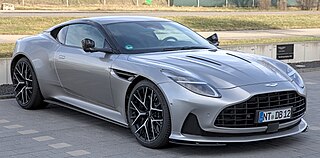
Aston Martin Lagonda Global Holdings PLC is a British manufacturer of luxury sports cars and grand tourers. Its predecessor was founded in 1913 by Lionel Martin and Robert Bamford. Steered from 1947 by David Brown, it became associated with expensive grand touring cars in the 1950s and 1960s, and with the fictional character James Bond following his use of a DB5 model in the 1964 film Goldfinger. Their sports cars are regarded as a British cultural icon. Aston Martin has held a Royal Warrant as purveyor of motorcars to Charles III since 1982, and has over 160 car dealerships in 53 countries, making it a global automobile brand. The company is traded on the London Stock Exchange and is a constituent of the FTSE 250 Index. In 2003 it received the Queen's Award for Enterprise for outstanding contribution to international trade. The company has survived seven bankruptcies throughout its history.
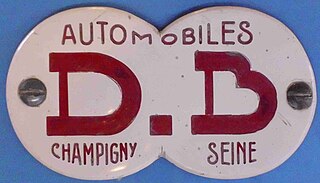
Deutsch-Bonnet (DB), is a brand of sports cars created in 1937 by Charles Deutsch and René Bonnet and disappeared in 1962.
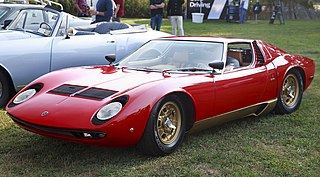
The Lamborghini Miura is a sports car produced by Italian automaker Lamborghini between 1966 and 1973. The car was the first supercar with a rear mid-engined two-seat layout, although the concept was first seen in a production road car with René Bonnet's Matra Djet, introduced in 1964. This layout has since become the standard for high-performance sports and supercars. When released, it was the fastest production road car.
Sir David Brown was an English industrialist, managing director of his grandfather's gear and machine tool business David Brown Limited and more recently David Brown Tractors, and once the owner of shipbuilders Vosper Thorneycroft and car manufacturers Aston Martin and Lagonda.

Walter Owen Bentley, was an English engineer who founded Bentley Motors Limited in London. He was a motorcycle and car racer as a young man. After making a name for himself as a designer of aircraft and automobile engines, Bentley established his own firm in 1919. He built the firm into one of the world's premier luxury and performance auto manufacturers, and led the marque to multiple victories at the 24 Hours of Le Mans. After selling his namesake company to Rolls-Royce Limited in 1931, he was employed as a designer for Lagonda, Aston Martin, and Armstrong Siddeley.
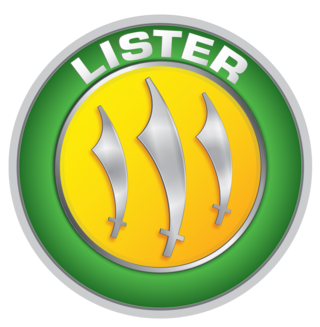
The Lister Motor Company Ltd. is a British sports car manufacturer founded by Brian Lister in 1954 in Cambridge, England, which became known for its involvement in motorsport. After buying the company in 1986, Laurence Pearce produced variants of the Jaguar XJS before producing a bespoke sports car, the Lister Storm. In 2013, Lister Cars was acquired by Lawrence Whittaker's company Warrantywise. Production of the original sports car restarted in 2014 and ten continuation Lister Jaguar Knobblys were built to celebrate Lister's 60th Anniversary. In 2016, the company announced the build and sale of the Lister Knobbly Stirling Moss. On 31 January 2018, the Lister LFT-666 based on the Jaguar F-Type was announced.

The Aston Martin DB2 is a grand tourer that was sold by Aston Martin from May 1950 until April 1953. The successor to the 2-Litre Sports model, it had a comparatively advanced dual overhead cam 2.6 L Lagonda straight-6 engine in place of the previous overhead valve engine straight-four engine. It was available as a closed, 2-seater coupé which Aston Martin called a sports saloon, and later also as a drophead coupé, which accounted for a quarter of the model's total sales. The closed version had some success in racing.
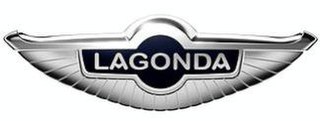
Lagonda is a British luxury car brand established in 1906, which has been owned by Aston Martin since 1947. The trade-name has not had a continuous commercial existence, being dormant several times, most recently from 1995 to 2008, 2010 to 2013, and 2016 onward.

The Aston Martin DB2/4 is a grand tourer produced by Aston Martin from 1953 until 1957. It was available as a 2+2 hatchback saloon, drophead coupé (DHC) and 2-seat fixed-head coupé. A small number of Bertone bodied spiders were commissioned by private buyers.

The Aston Martin Vantage is a series of hand-built sports cars from the British automotive manufacturer Aston Martin. Aston Martin has previously used the "Vantage" name on high-performance variants of their existing GT models, notably on the Virage-based car of the 1990s. The modern car, in contrast, is the leanest and most agile car in Aston's lineup. As such, it is intended as a more focused model to reach out to potential buyers of cars such as the Porsche 911 as well as the exotic sports and GT cars with which Aston Martins traditionally compete.

Paramount Cars was a British company which produced the Paramount automobile between 1950 and 1956. Founded by WA Hudson and S Underwood from Derbyshire, the company initially manufactured cars in Swadlincote with production moving shortly after to Melbourne and then to Leighton Buzzard. Two models were produced, the Paramount Ten and the Paramount 1½-Litre.

The Lagonda Straight-6 is a famous automobile engine used by Aston Martin and Lagonda marques in the 1950s. Designed by Willie Watson under the supervision of Walter Owen Bentley of Bentley Motors Limited, it vaulted Aston Martin to fame as a maker of desirable sports and racing cars.

The Lagonda 2.6-Litre was an automobile produced in England by Lagonda from 1948 to 1953. It was the first model from that company following its purchase by David Brown in 1947, and was named for the new straight-6 engine which debuted with the car. The Lagonda straight-6 engine was designed by W. O. Bentley and would propel Lagonda's new parent company, Aston Martin, to fame.

The Aston Martin AMR1 was a Group C formula racing car developed in 1989 for car manufacturer Aston Martin. It participated in the 1989 World Sports Prototype Championship and 1989 24 Hours of Le Mans.
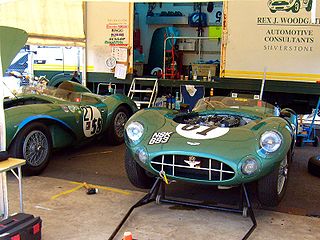
The Aston Martin DBR1 is a sports racing car built by Aston Martin starting in 1956, intended for the World Sportscar Championship as well as non-championship sportscar races at the time. It is most famous as the victor of the 1959 24 Hours of Le Mans, Aston Martin's only outright victory at the endurance classic. It is one of only three cars in the 1950s to win both the World Sports Car Championship and Le Mans 24 Hours in the same year. In addition the six World Sports Car Championship victories was a record for any car in the 1950s and remained a record in the championship until surpassed by the Ferrari 250TR. The three consecutive triumphs in 1959 at the Nürburgring, Le Mans and the Tourist Trophy equalled the record set by the Ferrari 250TR with its three consecutive victories at the start of the 1958 season.

The Aston Martin DBR2 was a sports racing car built in 1957 as a sibling to the Aston Martin DBR1, yet competing in a larger engine capacity group.
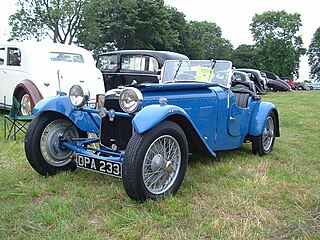
HRG Engineering Company also known as HRG, was a British car manufacturer based in Tolworth, Surrey. Founded in 1936 by Major Edward Halford, Guy Robins and Henry Ronald Godfrey, its name was created from the first letter of their surnames. Cars were produced under the HRG name from 1935 to 1956.

The Aston MartinAtom is a prototype automobile built by Aston Martin (AM). Construction of the car began in 1939 and was completed in 1940. The Atom is one of the first fully functional concept cars ever built. Aston Martin explored several new technologies with the Atom, and its chassis design was the basis for the platform used by AM's post-war models well into the late 1950s.

The Aston Martin Vantage is a two-seater sports car built by British manufacturer Aston Martin since 2018. It replaces the previous model which had been in production for 12 years.




















